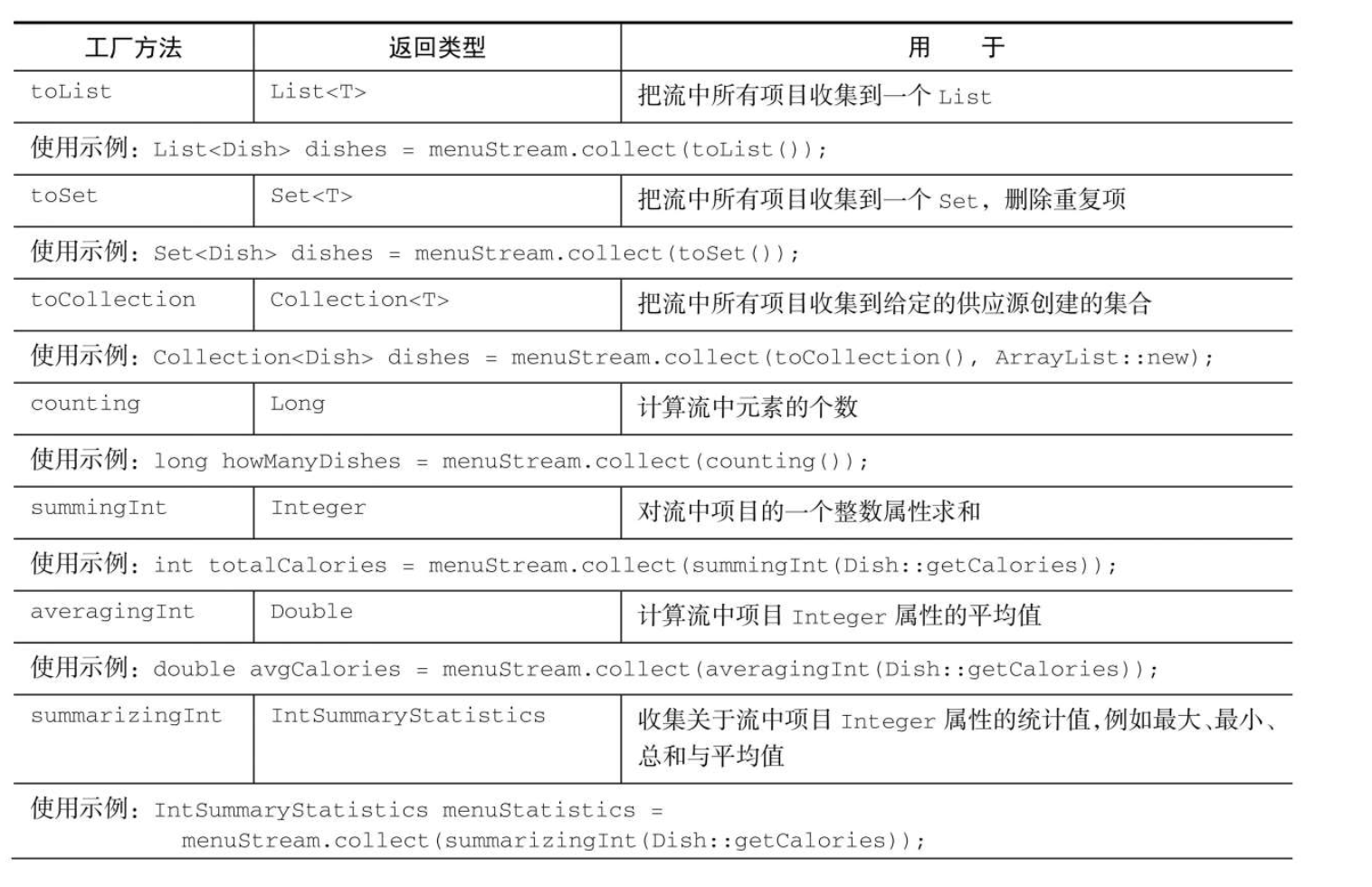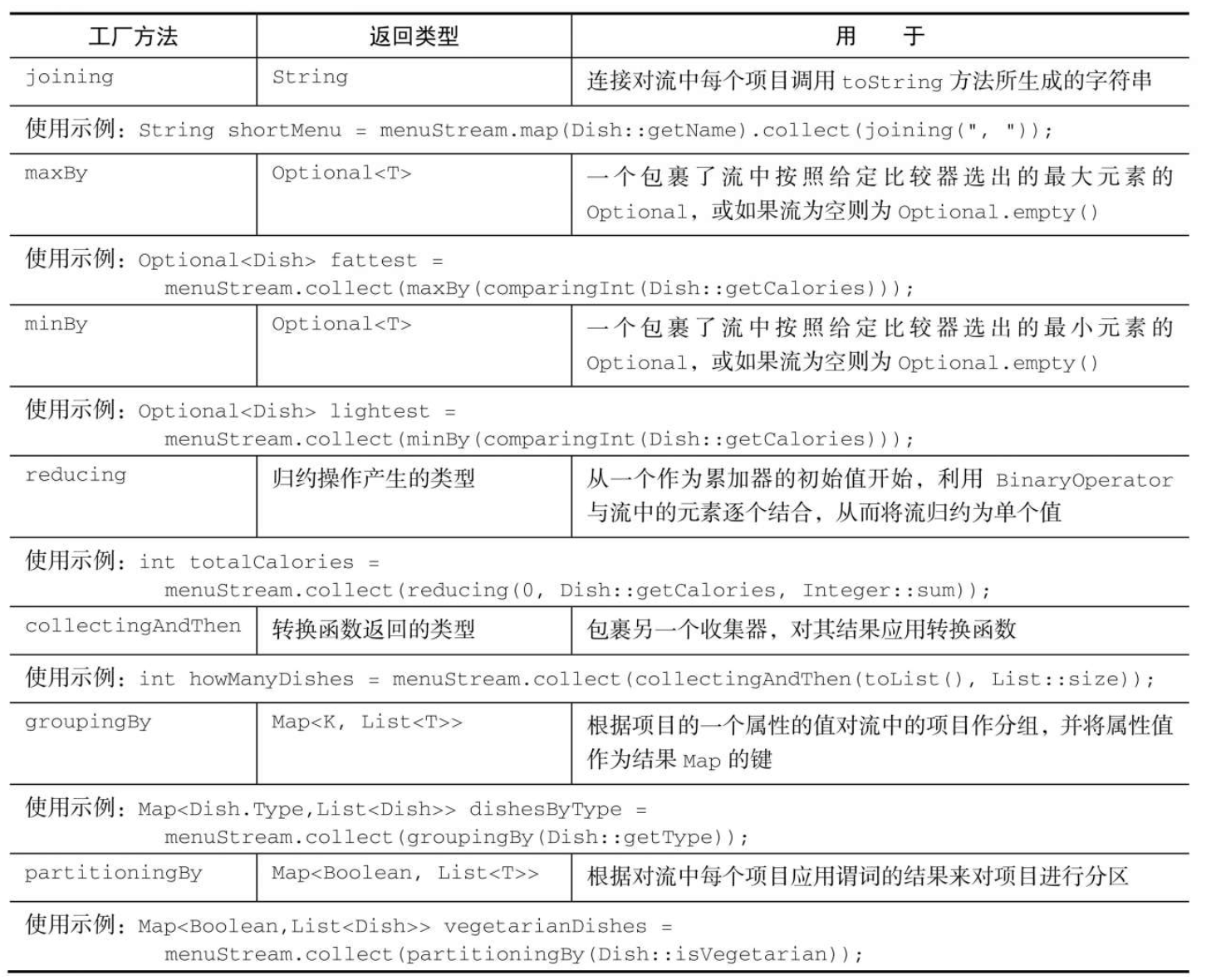Stream
遍历数据集的高级迭代器。使用StreamApi让代码:
声明式:更简洁,更易读; 可复合:更灵活; 可并行:性能更好;
使用流
流的使用一般包括三件事:
一个数据源(如集合)来执行一个查询; 一个中间操作链,形成一条流的流水线; 一个终端操作,执行流水线,并能生成结果;
流操作
创建操作
创建流
集合
List<Employee> employees = EmployeeData.getEmployees();
// default Stream<E> stream() : 返回一个顺序流
Stream<Employee> stream = employees.stream();
// default Stream<E> parallelStream() : 返回一个并行流
Stream<Employee> parallelStream = employees.parallelStream();数组
int[] arr = new int[]{1,2,3,4,5,6};
//调用Arrays类的static <T> Stream<T> stream(T[] array): 返回一个流
IntStream stream = Arrays.stream(arr);stream的of()
Stream<Integer> stream = Stream.of(1, 2, 3, 4, 5, 6);文件流
Java中用于处理文件等I/O操作的NIO API(非阻塞I/O)已更新,以便利用StreamAPI。java.nio.file.Files中的很多静态方法都会返回一个流。例如,一个很有用的方法是Files.lines,它会返回一个由指定文件中的各行构成的字符串流。
Files.lines得到一个流,其中的每个元素都是给定文件中的一行
Stream<String> lines = Files.lines(Paths.get("/comprehensive-code/aaaa.txt")无限流
迭代 Stream.iterate
Stream.iterate(0,n -> n+2).limit(5).forEach(System.out::println);生成 Stream.generate
Stream.generate(Math::random).limit(10).forEach(System.out::println);由iterate和generate产生的流会用给定的函数按需创建值,因此可以无穷无尽地计算下去!一般来说,应该使用limit(n)来对这种流加以限制,以避免打印无穷多个值。
中间操作
可以连接起来的流操作。
筛选
filter过滤操作
distinct去重操作
List<Employee> list = EmployeeData.getEmployees();
// filter(Predicate p)——接收 Lambda , 从流中排除某些元素。
Stream<Employee> stream = list.stream();
//练习:查询员工表中薪资大于7000的员工信息
stream.filter(e -> e.getSalary() > 7000).forEach(System.out::println);
切片
limit
// limit(n)——截断流,使其元素不超过给定数量。
list.stream().limit(3).forEach(System.out::println);skip
// skip(n) —— 跳过元素,返回一个扔掉了前 n 个元素的流。若流中元素不足 n 个,则返回一个空流。与 limit(n) 互补
list.stream().skip(3).forEach(System.out::println);takeWhile(Java 9方法)遭遇第一个不符合要求的元素时停止处理
dropWhile(Java 9方法)遭遇第一个符合要求的元素时停止处理
映射
map
// map(Function f)——接收一个函数作为参数,将元素转换成其他形式或提取信息,该函数会被应用到每个元素上,并将其映射成一个新的元素。
List<String> list = Arrays.asList("aa", "bb", "cc", "dd");
list.stream().map(str -> str.toUpperCase()).forEach(System.out::println);flatmap
// flatMap(Function f)——接收一个函数作为参数,将流中的每个值都换成另一个流,然后把所有流连接成一个流。
Stream<String> stringStream = Stream.of("aaaaa", "vvvvv", "dddddd", "avd");
List<String> collect = stringStream
.map(string -> string.split(""))
.flatMap(Arrays::stream).collect(Collectors.toList());
System.out.println(collect);
排序
sorted
// sorted()——自然排序
List<Integer> list = Arrays.asList(12, 43, 65, 34, 87, 0, -98, 7);
list.stream().sorted().forEach(System.out::println);
// sorted(Comparator com)——定制排序
List<Employee> employees = EmployeeData.getEmployees();
employees.stream().sorted( (e1,e2) -> {
int ageValue = Integer.compare(e1.getAge(),e2.getAge());
if(ageValue != 0){
return ageValue;
}else{
return -Double.compare(e1.getSalary(),e2.getSalary());
}
}).forEach(System.out::println);
终止操作
关闭流的操作。
查找
findAny
// findFirst——返回第一个元素
Optional<Employee> employee = employees.stream().findFirst();findFirst
// findAny——返回当前流中的任意元素
Optional<Employee> employee1 = employees.parallelStream().findAny();
匹配
anyMatch
// anyMatch(Predicate p)——检查是否至少匹配一个元素。
// 练习:是否存在员工的工资大于 10000
boolean anyMatch = employees.stream().anyMatch(e -> e.getSalary() > 10000);allMatch
// allMatch(Predicate p)——检查是否匹配所有元素。
// 练习:是否所有的员工的年龄都大于18
boolean allMatch = employees.stream().allMatch(e -> e.getAge() > 18);noneMatch
// noneMatch(Predicate p)——检查是否没有匹配的元素。
// 练习:是否存在员工姓“雷”
boolean noneMatch = employees.stream().noneMatch(e -> e.getName().startsWith("雷"));
求和 最大和最小值
count
// count——返回流中元素的总个数
long count = employees.stream().filter(e -> e.getSalary() > 5000).count();
max min
// max(Comparator c)——返回流中最大值
// 练习:返回最高的工资:
Stream<Double> salaryStream = employees.stream().map(e -> e.getSalary());
Optional<Double> maxSalary = salaryStream.max(Double::compare);
System.out.println(maxSalary);
// min(Comparator c)——返回流中最小值
// 练习:返回最低工资的员工
Optional<Employee> employee = employees.stream().min((e1, e2) -> Double.compare(e1.getSalary(), e2.getSalary()));
System.out.println(employee);
归约
redue
// reduce(T identity, BinaryOperator)——可以将流中元素反复结合起来,得到一个值。返回 T
// 练习1:计算1-10的自然数的和
List<Integer> list = Arrays.asList(1,2,3,4,5,6,7,8,9,10);
Integer sum = list.stream().reduce(0, Integer::sum);
System.out.println(sum);
// reduce(BinaryOperator) ——可以将流中元素反复结合起来,得到一个值。返回 Optional<T>
// 练习2:计算公司所有员工工资的总和
List<Employee> employees = EmployeeData.getEmployees();
Stream<Double> salaryStream = employees.stream().map(Employee::getSalary);
Optional<Double> sumMoney = salaryStream.reduce(Double::sum);
// Optional<Double> sumMoney = salaryStream.reduce((d1,d2) -> d1 + d2);
System.out.println(sumMoney.get());
收集
collect方法,主要使用收集器Collector
数值流
减少装箱拆箱操作,Stream API还提供了原始类型流特化,专门支持处理数值流的方法。IntStream、DoubleStream和LongStream
映射到数值流
mapToInt mapToDouble mapToLong
转换回对象流
boxed
默认值OptionalInt
Stream<Integer> integerStream = Stream.of(1, 2, 3, 4, 5, 6);
OptionalInt max = integerStream.mapToInt(Integer::intValue).max();
System.out.println(max.orElse(1));
Collectors
Collector接口中方法的实现决定了如何对流执行归约操作。但Collectors实用类提供了很多静态工厂方法,可以方便地创建常见收集器的实例,只要拿来用就可以了。
归约操作
Collectors.counting
// 集合个数
Long collect = employees.stream().collect(Collectors.counting());
System.out.println(collect);
System.out.println(employees.stream().count());Collectors.maxBy 和 Collectors.minBy
//最大最小值
Optional<Employee> collect1 = employees.stream()
.collect(Collectors.maxBy(Comparator.comparingDouble(Employee::getSalary)));
System.out.println(collect1.get());
Optional<Employee> collect2 = employees.stream()
.collect(Collectors.minBy(Comparator.comparingDouble(Employee::getSalary)));
System.out.println(collect2.get());Collectors.summingInt
// 汇总
Integer collect3 = employees.stream().collect(Collectors.summingInt(Employee::getId));
System.out.println(collect3);Collectors.summingLong和Collectors.summingDouble方法的作用完全一样,可以用于求和字段为long或double的情况。
Collectors.averagingInt,连同对应的averagingLong和averagingDouble可以计算数值的平均数;
summarizingInt,summarizingLong和summarizingDouble可以计算总和、平均值、最大值和最小值;得到IntSummaryStatistics,LongSummaryStatistics和DoubleSummaryStatistics
Collectors.joining
joining工厂方法返回的收集器会把对流中每一个对象应用toString方法得到的所有字符串连接成一个字符串。
// 2个重载版本
List<Employee> employees = EmployeeData.getEmployees();
String collect = employees.stream().map(Employee::getName)
.collect(Collectors.joining());
System.out.println(collect);
// 添加分隔符
String collect1 = employees.stream().map(Employee::getName).collect(Collectors.joining(","));
System.out.println(collect1);
// 添加分隔符,开头 结尾
String collect2 = employees.stream().map(Employee::getName)
.collect(Collectors.joining(",", "开头", "结尾"));
System.out.println(collect2);Collectors.reducing
需要三个参数:
1.第一个参数是归约操作的起始值,也是流中没有元素时的返回值,所以很显然对于数值和而言0是一个合适的值。
2.转换函数
3.是一个BinaryOperator,将两个项目累积成一个同类型的值
List<Employee> employees = EmployeeData.getEmployees();
Integer collect = employees.stream().collect(Collectors.reducing(0, Employee::getId, (a, b) -> a + b));
System.out.println(collect);
Optional<Employee> collect3 = employees.stream()
.collect(Collectors.reducing((a, b) -> a.getSalary() > b.getSalary() ? a : b));
System.out.println(collect3);
Optional<Integer> collect1 = Stream.of(1, 2, 3, 4, 5).collect(Collectors.reducing((a, b) -> a + b));
System.out.println(collect1.get());
Integer collect2 = Stream.of(1, 2, 3, 4, 5).collect(Collectors.reducing(10, (a, b) -> a + b));
System.out.println(collect2);
分组
Collectors.groupingBy。
List<Employee> employees = EmployeeData.getEmployees();
// 按工资分组
Map<Double, List<Employee>> collect = employees.stream()
.collect(Collectors.groupingBy(Employee::getSalary));
System.out.println(collect);
Map<String, List<Employee>> collect1 = employees.stream().collect(Collectors.groupingBy(employee -> {
if (employee.getSalary() > 9000) {
return "gao";
} else if (employee.getSalary() > 500) {
return "zhong";
} else {
return "di";
}
}));
System.out.println(collect1);
操作分组的元素
Collectors类重载了工厂方法groupingBy,除了常见的分类函数,它的第二变量也接受一个Collector类型的参数。
Map<Double, List<String>> collect2 = employees.stream()
.collect(Collectors.groupingBy(Employee::getSalary, Collectors.mapping(Employee::getName, Collectors.toList())));
System.out.println(collect2);
Collectors类通过mapping方法提供了另一个Collector函数,它接受一个映射函数和另一个Collector函数作为参数。作为参数的Collector会收集对每个元素执行该映射函数的运行结果。
有三个参数重载版本,多增加一个map生成工厂
HashMap<Double, List<Integer>> collect3 = employees.stream()
.collect(Collectors.groupingBy(Employee::getSalary, HashMap::new, Collectors
.mapping(Employee::getAge, Collectors.toList())));
多级分组
要实现多级分组,可以使用一个由双参数版本的Collectors.groupingBy工厂方法创建的收集器,它除了普通的分类函数之外,还可以接受collector类型的第二个参数。那么要进行二级分组的话,可以把一个内层groupingBy传递给外层groupingBy,并定义一个为流中项目分类的二级标准。
// 多级分组
Map<Double, Map<Integer, List<Employee>>> collect4 = employees.stream().collect
(Collectors.groupingBy(Employee::getSalary,Collectors.groupingBy(Employee::getAge)));
按子组收集数据
把收集器的结果转换为另一种类型
Map<Double, Optional<Employee>> collect5 = employees.stream().
collect(Collectors.groupingBy(Employee::getSalary, Collectors.maxBy(Comparator.comparing(Employee::getName))));
// 把收集器的结果转换为另一种类型
Map<Double, Employee> collect6 = employees.stream().
collect(Collectors.groupingBy(Employee::getSalary, Collectors.collectingAndThen(Collectors.maxBy(Comparator.comparingInt(Employee::getId)), Optional::get)));与groupingBy联合使用的其他收集器
Map<Double, Set<String>> collect7 = employees.stream().collect(
Collectors.groupingBy(Employee::getSalary, Collectors.mapping(Employee::getName, Collectors.toSet())));联合使用其他的收集器,可以产生各种类型数据。继续摸索使用中
分区
分区函数返回一个布尔值,这意味着得到的分组Map的键类型是Boolean,于是它最多可以分为两组——true是一组,false是一组。
List<Employee> employees = EmployeeData.getEmployees();
Map<Boolean, List<Employee>> collect = employees.stream()
.collect(Collectors.partitioningBy(employee -> employee.getSalary() > 1000));
总结

